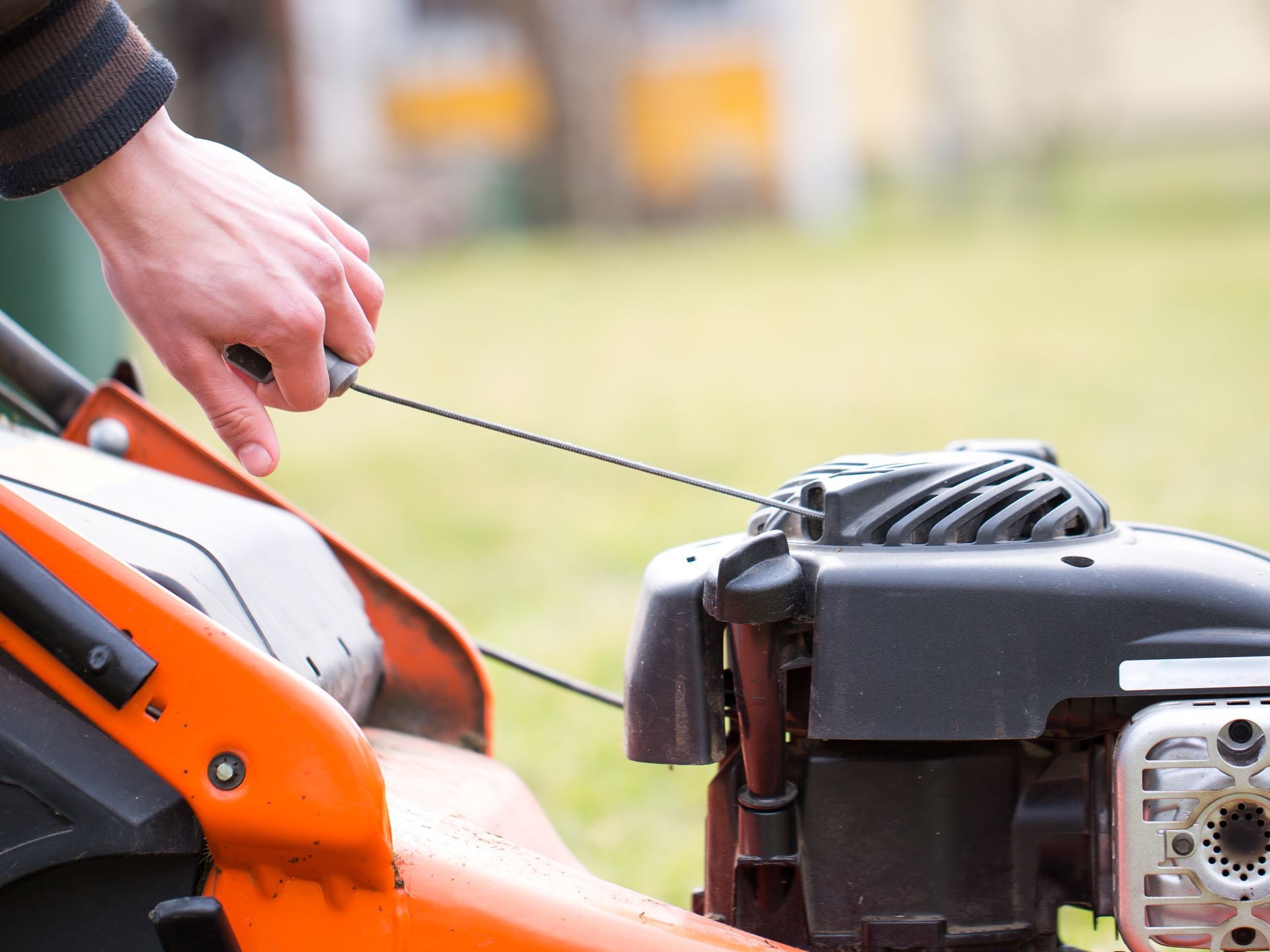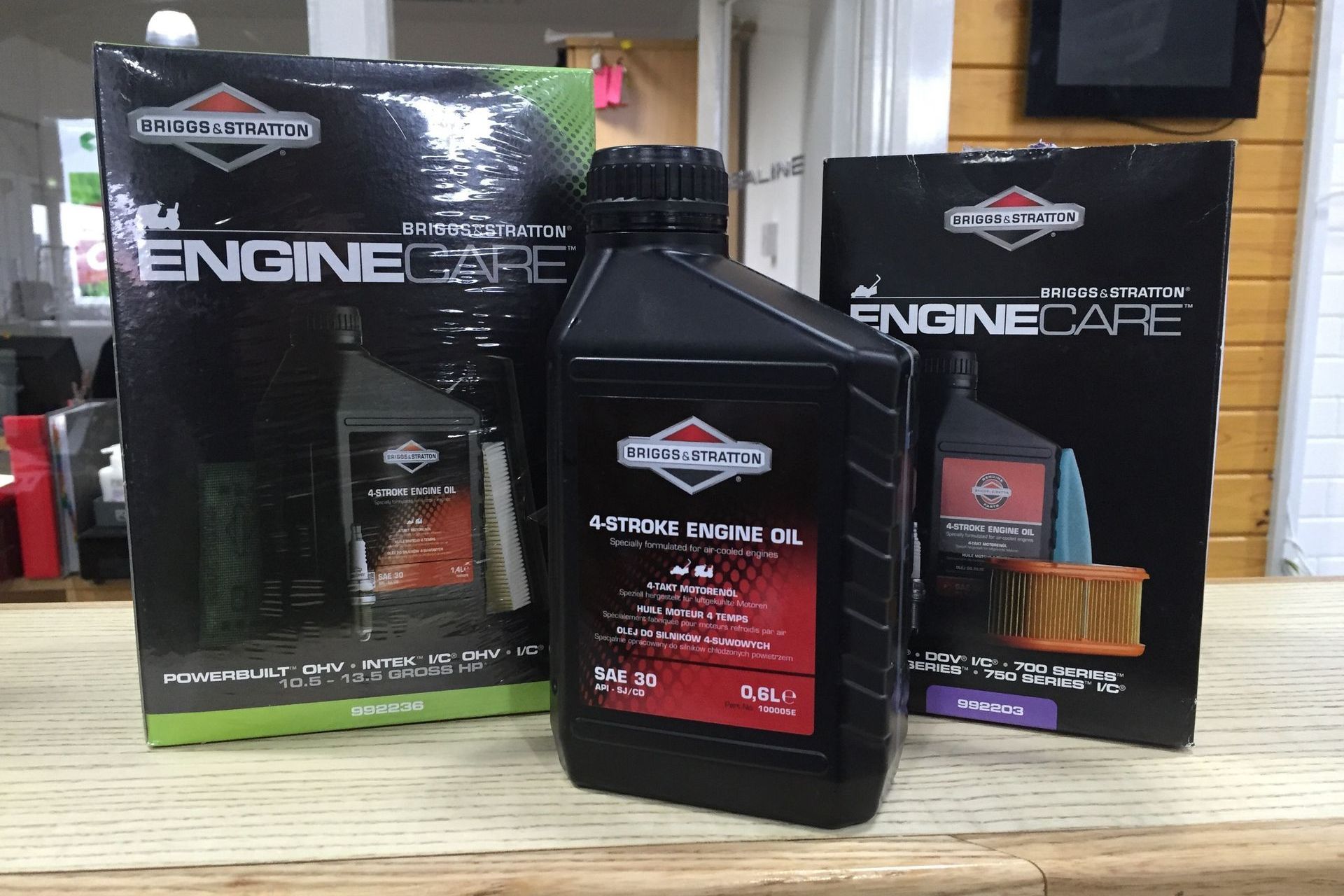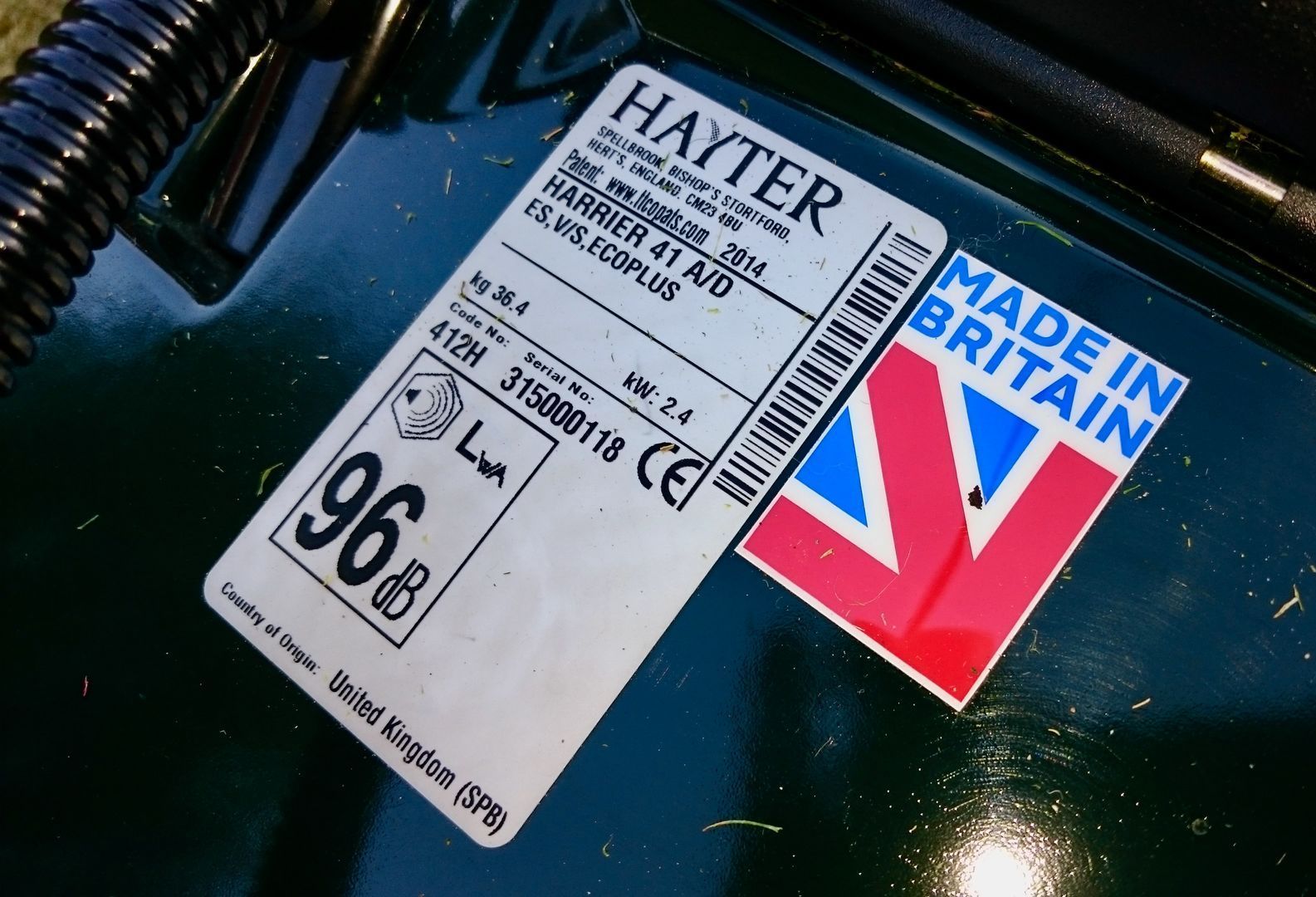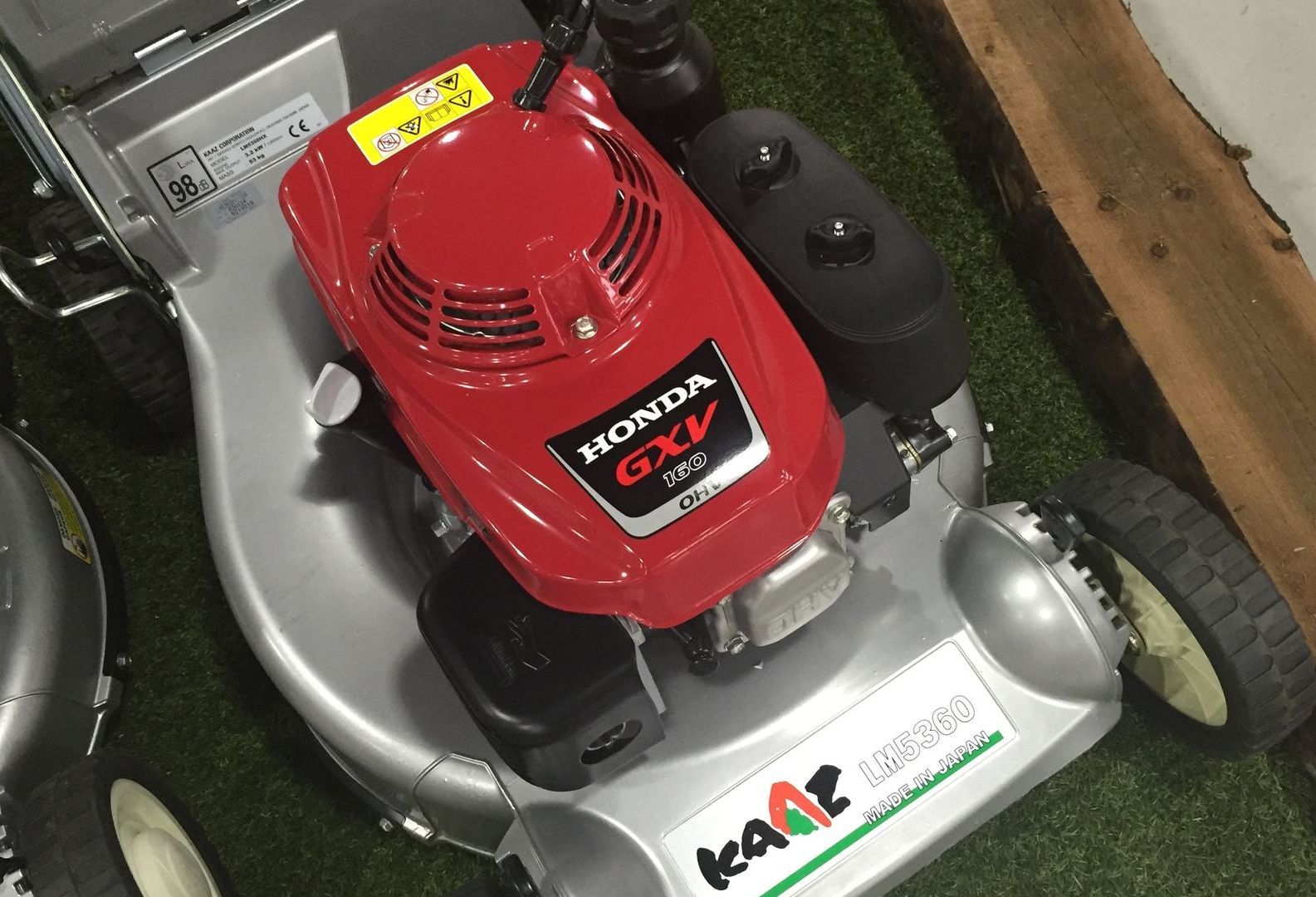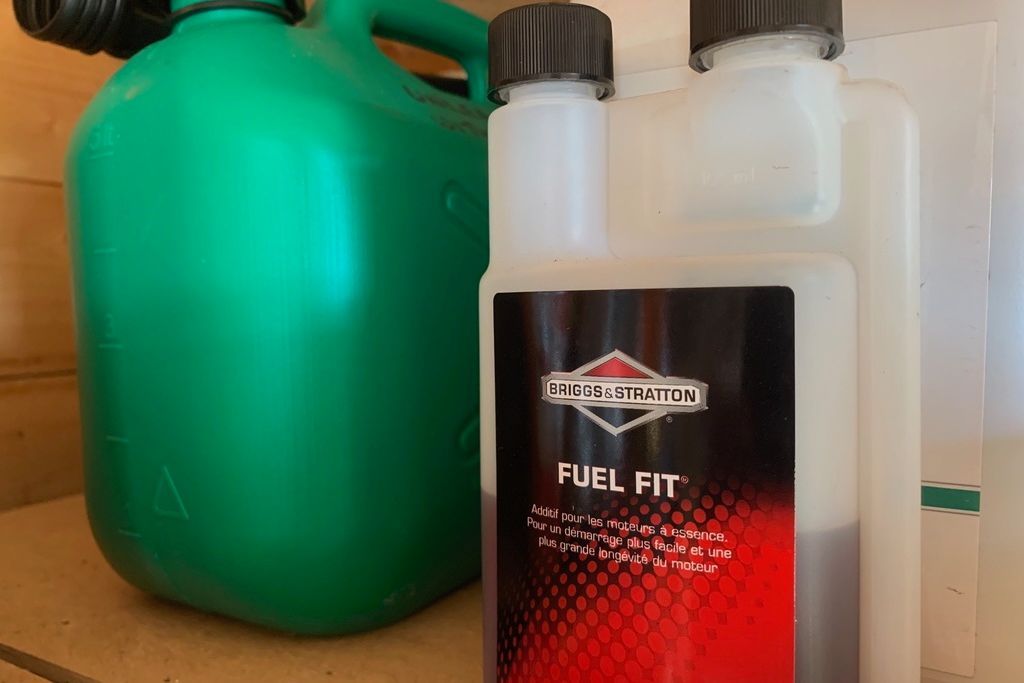*Important Information: As an audience supported website, if you purchase an item after clicking an external link or advertisement marked with an asterisk (*) on this website, we may receive a commission. This does not change the price you pay.
Despite a significant increase in sales of cordless machinery, petrol mowers remain a very definite favourite with a significant number of British gardeners. Image Credit: Author
Petrol Lawnmowers
The most powerful mowers on sale in the UK, or anywhere else for that matter, have one thing in common – they’re all powered by petrol.
Despite the arrival of higher power corded and cordless electric machines – that situation is unlikely to change any time soon. And whilst sales of li-ion battery electric mowers continue to grow, petrol machines will still be a feature on British lawns for many years to come.
Despite a significant increase in sales of cordless machinery, petrol mowers remain a very definite favourite with many British gardeners. Image Credit: Author
Petrol lawn mowers come in a wide range of designs, sizes, and specifications. There's a model to suit virtually any garden — from smaller, suburban gardens, to expansive rural lawns. With the possible exception of the tiniest outdoor spaces, there’s almost certainly a petrol-powered machine to fit your needs, your lawn, and your budget.
For smaller gardens, reliable entry-level petrol mowers are readily available around the £250 mark, offering solid performance without excessive complexity. For larger or more demanding lawns, expect to invest at least £400 for a capable base model. Premium models can exceed £1,000, dependent upon cutting width, power and feature set.
The Power To Perform
When choosing a petrol machine, some would argue it makes sense to choose the most powerful machine for your money. This is certainly true if you opt for a self-propelled mower, where the engine must provide motive as well as cutting power.
All petrol engine mowers sold today in the UK are 4-stroke models. Two-stroke mowers, fell afoul of stringent emission laws many years ago, with their place in the market taken both by an improved range of 4-stroke machines, and cordless mowers.
Whilst 4-stroke petrol lawnmower engines have (so far) escaped the cull that saw the demise of 2-stroke machines, they have undergone significant refinement and improvement. Based in Milwaukee, USA, Briggs & Stratton, is the world’s largest manufacturer of lawnmower engines. Their engines can be found on many top brand machines on sale today. It’s reassuring to know that current generation Briggs & Stratton engines emit up to 75% less pollutants, than comparable engines manufactured by the company before 1995. Driven by both consumer demand and environmental regulation, similarly impressive improvements are claimed by other manufacturers too.
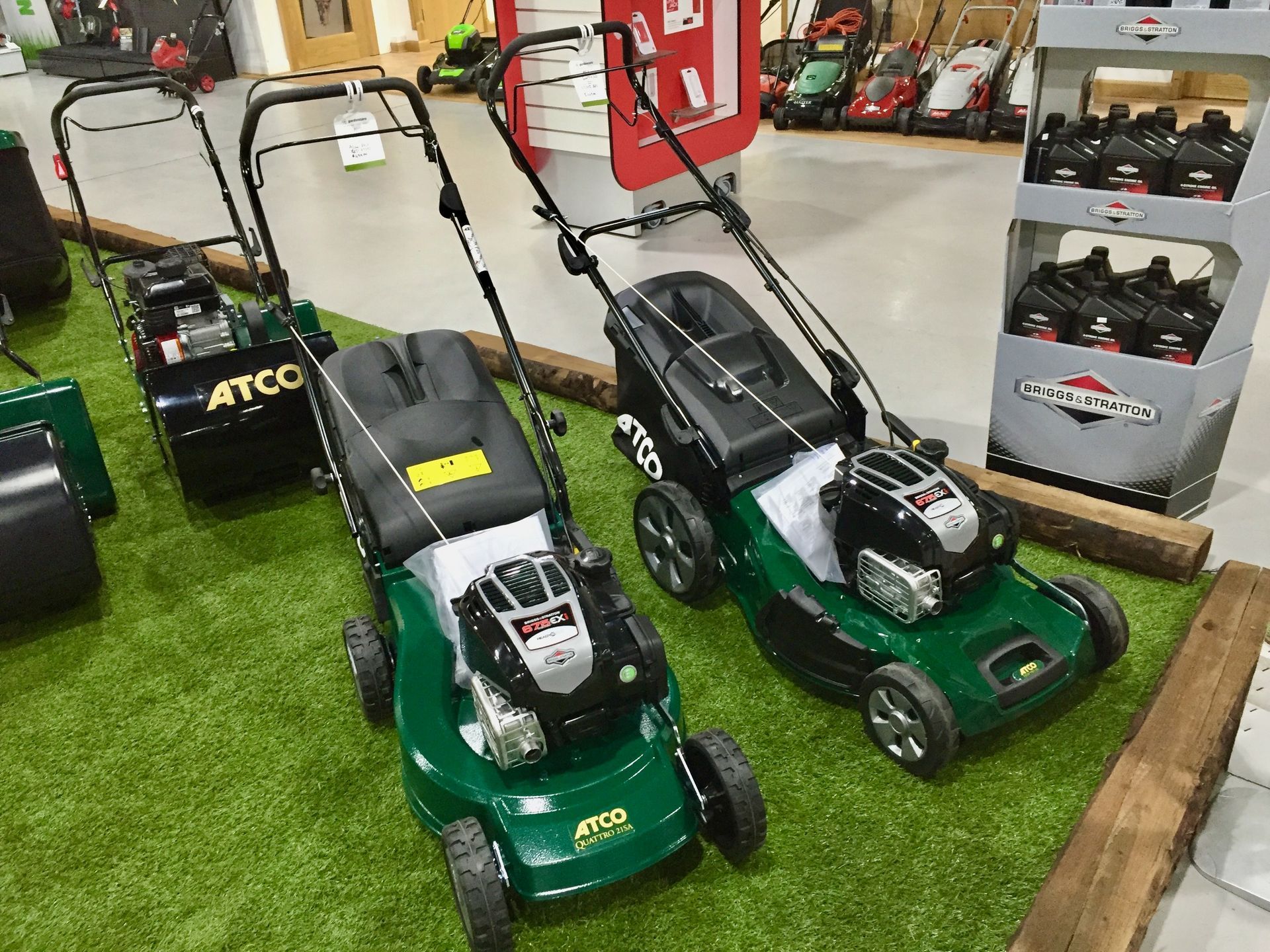
Modern engines, such as these Briggs & Stratton models fitted to ATCO mowers, are significantly more efficient than their predecessors. Image Credit: Author
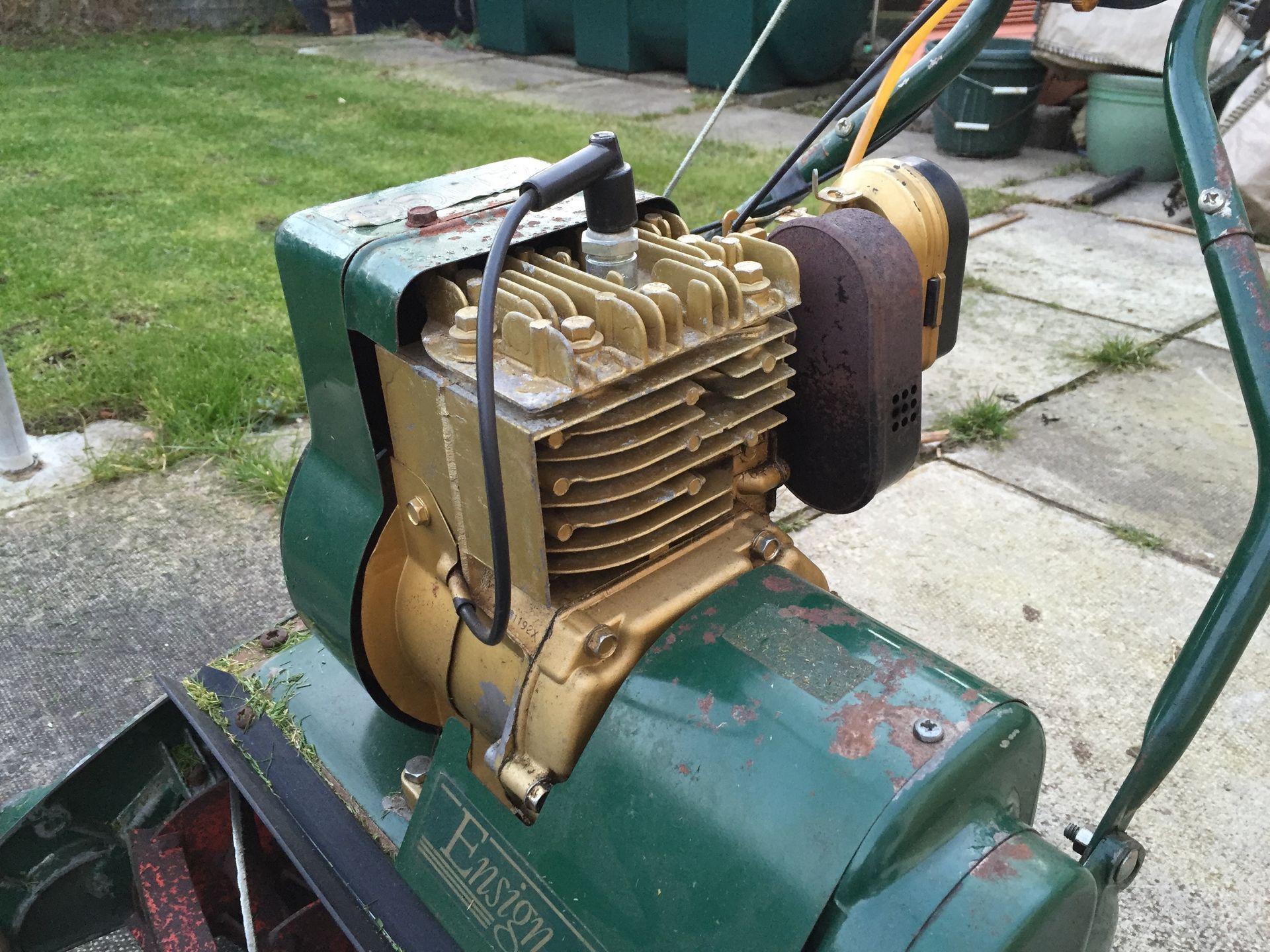
An older ATCO Ensign self-propelled cylinder mower, fitted with a Tecumseh ATQ series petrol engine. Robust and reliable, but not as efficient as today's modern, petrol engines.
Image Credit: Author
Petrol Advantages
The primary appeal of a petrol lawn mower lies in one word: power. No other mower delivers the same raw cutting force, making petrol models ideal for tackling tougher grass conditions and larger lawns with ease. In general, more engine power means a cleaner, more effortless cut — even in challenging terrain or when cutting longer grass. But petrol's advantages, extend far beyond raw cutting power:
- Freedom from the cord: Unlike corded electric mowers, petrol machines offer true freedom of movement. There’s no cable to tangle, snag, or accidentally sever; no need for extension leads, RCD-protected sockets, or mains connections. This makes petrol mowers especially well-suited for gardens with complex layouts, distant areas of lawns, or obstacles where trailing a cord would be impractical — or even downright dangerous;
- Maximum uptime, minimum downtime: Compared to battery-powered models, petrol mowers are arguably better for continuous operation over extended periods. With a cordless mower, once the battery runs flat, unless you have a fully charged spare on hand, you’ll need to pause and wait, while the battery recharges. With petrol? Just refuel, and you’re back in action within minutes. While battery technology is improving, we're still some way from a future where a five-minute charge equals hours of uninterrupted mowing. Until then, petrol remains the go-to option for larger properties, and those who value maximum uptime without interruption;
- Value and choice: Petrol mowers often come with a lower initial purchase cost than equivalent cordless battery electric mowers, though that gap is narrowing. What’s more, the petrol mower market is vast, with a huge variety of models tailored to practically every lawn type, budget, and user need;
- Repairability and longevity: Another major advantage of petrol machines is serviceability. Most petrol engines can be repaired, rebuilt, or replaced with relative ease. In contrast, some electric models — particularly budget cordless units — feature motor systems that are not always economically viable to repair if they fail;
- Tried, tested and trusted technology: Petrol power has been around for over 100 years and is a mature and widely supported technology.
Petrol Disadvantages
Petrol engine lawn mowers are often the go-to choice for users requiring high performance and durability. They typically deliver more cutting power than electric alternatives, offer unrestricted mobility compared to corded models, and are particularly well-suited for larger lawns or demanding, frequent use. But there are some trade-offs.
- Maintenance costs: For a smaller garden, a good quality, branded, electric, corded mower will cost less than a comparable petrol mower, whilst a cordless mower will almost certainly cost more. But the initial purchase cost is only part of the story. Aside from having its blade sharpened periodically, an electric machine (whether corded or cordless) requires little professional maintenance. A petrol-engine machine however, requires more significant maintenance. To comply with most manufacturer’s warranty requirements, petrol machines should be serviced at least annually by an approved professional. For a very basic service, you might expect to pay upwards of £60. For a more thorough service, on a more sophisticated machine, you could expect to part with £100 or more, each and every year;
- Running costs: Over a season, fuel costs for a petrol mower, will almost certainly be greater than for a comparable electric model. Given the volatility of energy prices over recent years, the temptation to publish worked examples has been resisted - not least because, as soon as they are published, they’re out of date. But even when petrol prices are relatively low and electricity prices spike – an electric mower will still cost less to operate than a comparable petrol model;
- Environmental considerations: Whilst today’s petrol engine machines consume less fuel, emit fewer particulates and pollutants, and are quieter in operation than ever before, it would be a stretch to describe them as either clean or green. Using a petrol-powered machine in itself is never going to melt a single ice cap or endanger a single polar bear. But petrol lawnmowers do emit pollutants, and they do generate noise. If it’s low emissions and peace and quiet you require, you'll want to consider a battery or mains electric machine;
- Weight: Petrol engines and petrol mowers tend to be heavier than both corded electric and battery-powered alternatives. This can make them more difficult to manoeuvre around corners, and more awkward to use in confined spaces. However, if you’re intent on a petrol-powered machine and weight is a concern, a self-propelled mower can sometimes be the answer. In a self-propelled mower, with the engine providing both cutting and motive power – the physical effort required to operate the machine is much reduced. Off the lawn however, and even self-propelled mowers still need to be moved, shifted and sometimes lifted. So, if you’ve back troubles or suffer from restricted movement, you’ll probably want to check out a cordless or corded electric alternative;
- Storage: If you’ve a petrol mower, you’ll require a safe space to store the machine and its fuel. Petrol is a highly flammable liquid and unsuitable for storage inside your home. You’ll also need to invest in a purpose-designed and approved petrol storage container too.
Starting Process
For many users, the process of starting a petrol lawn mower can be a significant drawback. In fact, a study conducted by one engine manufacturer, found that nearly one in three petrol mower owners cited starting the engine as their greatest source of frustration.
The typical starting sequence involves a series of coordinated steps. Most petrol engines require priming — manually delivering fuel into the carburettor by pressing a flexible bulb on the side of the engine — followed by pulling a starter cord, whilst simultaneously engaging the operating bail on the handlebar.
This setup, is technically known as a
recoil start mechanism, but is more commonly referred to as a
pull-start
system. While the design is mechanically robust and widely used, it can be awkward — particularly for users with limited upper body strength or mobility issues. In response, some modern petrol mowers now feature
electric start options to simplify the process.
Most petrol lawnmowers on sale today incorporate a 'recoil' starting mechanism, which requires the operator to pull a cord, to start the engine Image Credit: Simon Kadula
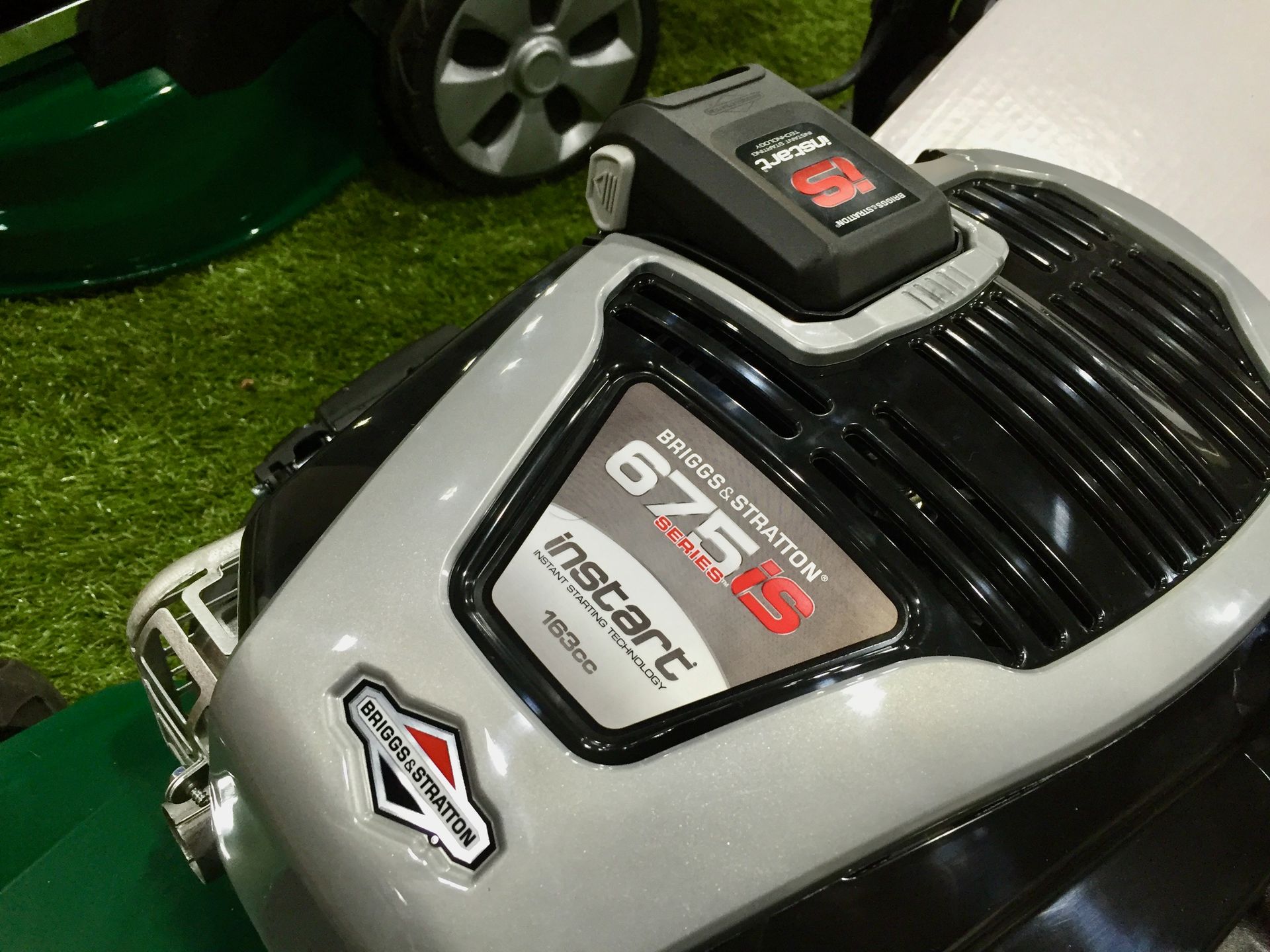
Briggs & Stratton's 675iS engine integrates lithium-ion electric starting technology directly into the engine for ease of starting and simple charging.
Image Credit:
Author
Smarter Starting
Recognising that the traditional recoil start can be a barrier for many users, several engine manufacturers have re-engineered the petrol mower starting process. Among the most notable is Briggs & Stratton, whose innovations aim to simplify ignition without compromising engine performance.
Briggs' ReadyStart®, for instance, removes the need for manual priming entirely. It automatically meters the correct amount of fuel to the carburettor — helping to ensure reliable starts within two pulls of the cord, even in variable weather conditions. Taking ease-of-use a step further, the engine giant's InStart® system replaces the pull cord altogether. Powered by a compact lithium-ion battery, InStart® enables effortless starting at the push of a button or turn of a key. This electric-start technology brings petrol mowers closer to the convenience of battery-powered machines — while retaining the cutting power and endurance that petrol engines are renowned for.
Other manufacturers have introduced similar start-assist systems on selected models, with features like
auto choke, easy-pull mechanisms, and electric starters, all aimed at making petrol mowers more user-friendly. If you find traditional recoil starting awkward or physically demanding, it's well worth looking for models with these systems. Better still, consider visiting an independent garden machinery specialist, and asking for a hands-on demo; many will be happy to let you try, before you buy.
Servicing
During a machine's warranty period, most lawnmower manufacturers require that servicing be carried out by a professionally trained and authorised technician. This is a standard condition for maintaining warranty coverage. It also ensures your machine remains in optimal working order, for longer. However, once the warranty expires, you're no longer confined to the manufacturer's dealer network — and that opens the door to more flexible and frequently more cost-effective servicing options.
Across the UK, thousands of independent lawnmower service engineers offer expert maintenance services and repair, for all types of garden and horticultural machinery. These professionals can sometimes provide faster turnaround times and more competitive pricing than main dealers. There’s a good chance there’s one near you — an online search will usually point you in the right direction.
For those with a bit of mechanical confidence, DIY servicing is another viable route. Many engine and mower manufacturers offer service kits, containing everything needed for routine maintenance — typically engine oil, air and fuel filters, and spark plugs, in a single, handy pack. These kits can cost less than half the price of a full dealer service, and with the right tools, a basic service can easily be completed in less than 30 minutes. A wealth of online tutorials, manufacturer guides, and community forums provide step-by-step instructions and troubleshooting tips, helping to make self-servicing accessible even for first-timers. So, before purchasing a mower, it’s wise to check whether service kits are available for that model — especially if you plan to maintain it yourself further down the line.
For more advanced machines — particularly those with hydrostatic drives, blade-brake clutches, or onboard electronics — professional servicing is always recommended regardless of warranty status. These systems often require specialist tools, diagnostic equipment, and technical expertise to maintain safety and operating efficiency.
In short, whether you stick with a dealer, hire an independent, or go hands-on, there’s a service path that fits your budget, skills, and your machine.
Lawnmower service kits are widely available from major engine manufacturers, and allow you to service your lawnmower affordably and easily, with only limited technical knowledge required. Image Credit: Author

There are thousands of independent garden machinery specialists throughout the UK, who specialise in the servicing and maintenance of lawnmowers and small petrol engines.
Image Credit: Anze Furlan
Overhead Valves (OHV) and Camshafts (OHC)
Nearly all modern petrol lawnmowers are powered by engines featuring either an Overhead Valve (OHV) or Overhead Camshaft (OHC) design. These configurations have become industry standards due to their efficiency, reliability, and improved fuel economy compared to older flathead engine designs.
However, if you're considering a second-hand mower, especially an older model, it's worth verifying the engine type — some legacy machines may still use side-valve configurations that lack the performance and durability of modern designs.
When mowing on uneven or sloping terrain, selecting a mower with an OHV or OHC engine becomes particularly important. Both systems are engineered to maintain effective oil distribution throughout the engine, even when the mower isn’t operating on a perfectly level surface. This ensures consistent lubrication of critical components, reducing wear, and extending engine life. In contrast, older side-valve engines may struggle to maintain proper oil circulation on inclines or irregular ground, increasing the risk of premature engine failure due to poor lubrication.
In short: if you're buying used, and especially if your lawn has slopes or undulations, prioritise a mower equipped with an OHV or OHC engine. It's a small detail with potentially big implications for engine longevity and performance.
Engine Manufacturers
When selecting a petrol lawn mower, one of the most important decisions you'll make is choosing the engine manufacturer. Broadly, there are two categories:
- Third-party engines from established engine specialists such as Briggs & Stratton, Honda, Kohler, Loncin, or Subaru;
- Machinery manufacturer-branded engines, which are either built in-house or, manufactured by an external supplier, to a lawnmower manufacturer's specification. Examples include engines fitted to some models from AL-KO, Cobra, Harry, Stiga Group brands, Stihl and others.
Many manufacturers offer a choice between third party and own brand engines. For consumer-grade machines, there’s often little noticeable difference in day-to-day performance or reliability between these two options. However, when it comes to serviceability, long-term support, and parts availability, third-party engines typically offer clear advantages.
Why Choose a Third-Party Engine?
- Expanded service network: Leading engine manufacturers, such as Briggs & Stratton, maintain extensive, independent service networks in addition to those offered by machinery manufacturers. For example, Briggs alone supports over 10,000 authorised service centres across the UK and EU, greatly improving accessibility for routine maintenance and repair;
- DIY-friendly maintenance: Many third-party engine brands supply dedicated service kits, allowing owners to perform basic maintenance themselves — subject to warranty considerations. Containing everything required for a standard service, they make routine servicing straightforward and cost-effective;
- Parts availability: Replacement parts for third-party engines are generally more widely available, thanks to their use across a broad range of applications within and beyond the garden machinery sector. This can mean faster a faster turnaround if something goes wrong.
There is however a cost to be paid for these benefits. Well-known brands such as Honda, Subaru and Briggs & Stratton, generally command a premium, over comparable engines wearing a machinery manufacturer's logo.
Engine Capacity v Power Output
There was a time when an engine’s displacement, measured in cubic centimetres (cc), served as a reliable proxy for its power output. A larger engine meant more muscle — simple as that. But with modern advances in engine design and efficiency, capacity alone no longer tells the whole story. Today, it’s entirely possible for a 99cc engine to outperform an older 125cc model, or for a modern 150cc engine to deliver more cutting power than a previous-generation 175cc unit. This mirrors the automotive world, where highly efficient 1.0-litre turbocharged engines often produce more horsepower than older 1.4-litre units.
A Better Metric: Power Output in Kilowatts (kW)
Instead of focusing solely on engine size, a more accurate performance indicator is the engine’s power output, usually expressed in kilowatts (kW). This figure reflects the actual mechanical power the engine can deliver — and thus, how effectively it will handle tougher grass and larger lawns. Power ratings are often stated on the machine's product label. Alternatively, for more detailed figures, consult the engine manufacturer’s website, for a data sheet.
In short, when comparing petrol mowers, don’t be misled by the numbers on the side of the engine block.
Two engines with the same capacity can perform very differently
— so prioritise
actual power output over displacement, for a more accurate assessment of what a machine can really do.
Fuel Stabilisers: Protect Your Engine From The Inside Out
Modern petrol formulations are more prone to degradation than in the past — particularly when fuel is stored for extended periods. Ethanol content, in particular, can accelerate the breakdown of fuel, leading to varnish deposits, corrosion, and hard starting. That’s why adding a fuel stabiliser to your petrol isn't just a smart move — it's increasingly essential.
A high-quality fuel stabiliser offers multiple benefits:
- Prevents fuel from going stale for up to three years, depending on the storage conditions;
- Inhibits internal corrosion within the fuel system, tank, and storage container;
- Cleans the fuel system during engine operation, helping maintain performance and efficiency.
By keeping petrol chemically stable, today's fuel stabilisers ensure your mower will start reliably after months of storage, making the first start of spring as effortless as the last mow of autumn.
One of the most recognised products on the market is Briggs & Stratton’s "Fuel Fit", which has earned a solid reputation for effectiveness. However, many mower and engine manufacturers also offer their own branded stabilisers, and some retailers supply own-brand equivalents too. Based on hands-on experience, these products — regardless of branding — offer comparable protection and performance.
Pro Tip
For best results,
add stabiliser to fresh petrol, not old stock. Also, run the mower briefly after filling the tank. This helps to ensure that treated fuel circulates throughout the system.
Fuel stabilisers such as Briggs & Stratton Fuel Fit are widely available from garden machinery suppliers. Image Credit: Author
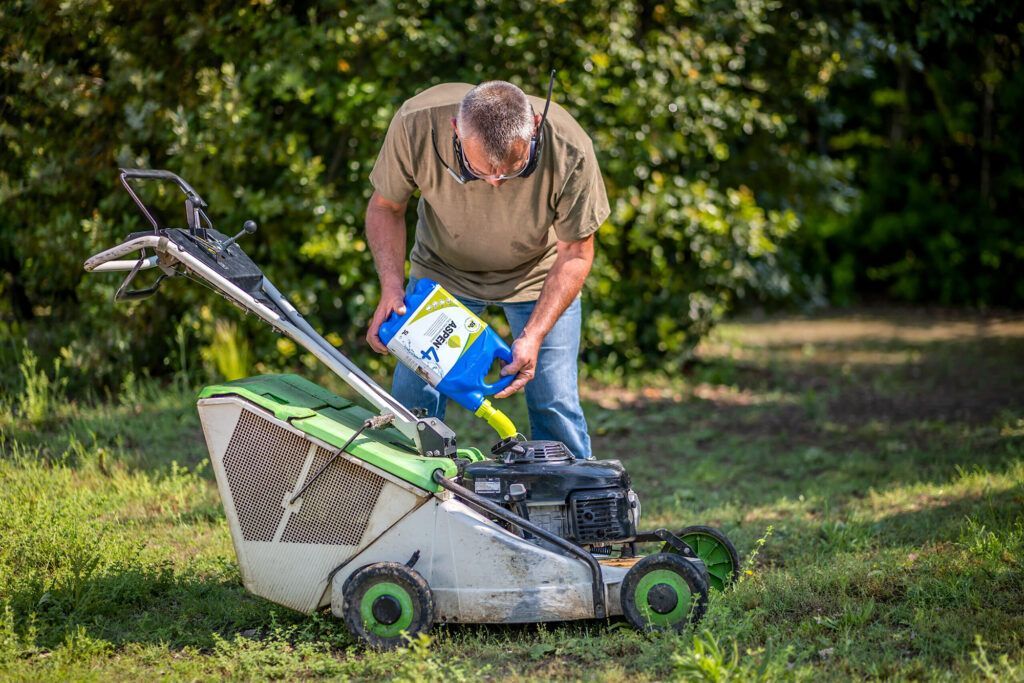
Alkalyte fuels, such as Aspen4, have a strong following among professional garden machinery users
Image Credit: Anglo American Oil Company
Alkylate Petrol: A Cleaner, High-Performance Petrol Alternative
Alkylate petrol represents a chemically refined, ultra-clean alternative to conventional forecourt fuel. Produced through a process known as alkylation, this specialist fuel is formulated by combining light hydrocarbons — by-products of crude oil distillation and catalytic cracking — into a liquid alkylate. The end result is a high-octane blend dominated by branched-chain paraffinic hydrocarbons, primarily isoheptane and isooctane.
This composition offers multiple advantages:
- Extremely low aromatic hydrocarbon content;
- Reduced sulphur and olefin levels;
- Exceptional anti-knock performance;
- Cleaner combustion.
These characteristics make alkylate petrol clean-burning, with reduced environmental and human health impacts compared to standard unleaded petrol. It also contributes to longer engine life, cleaner spark plugs, and fewer carbon deposits, making it particularly attractive for the two-stroke and small four-stroke engines used in garden machinery. Having run a machine on alkylate fuel for a season, the author can confirm it does indeed make a significant difference.
Availability and Brands
In the UK, the most widely recognised brand of alkylate fuel is Aspen, although other mower manufacturers and third-party suppliers also offer their own formulations. All conform to similar chemical standards, offering comparable performance and environmental benefits, irrespective of the label on the pack.
The Cost Barrier
Despite its advantages, the primary drawback of alkylate petrol is price. At the time of writing, forecourt petrol retails for around £1.40 per litre, while alkylate fuels typically command prices in the region of £5 per litre — a cost difference that can be hard to justify for domestic users. However, many professional landscapers and contractors consider the investment worthwhile, citing cleaner engine operation, fewer breakdowns, and reduced downtime as long-term cost savers.
Summary
Petrol-powered lawnmowers have long been the workhorse of British gardens — from suburban lawns to country estates.
They offer unrivalled power-to-weight ratios, runtime flexibility, and broad applicability. No other type of mower is as versatile across such a wide range of conditions, from small cottage lawns to sprawling formal grounds. With regular servicing and care, petrol mowers are built to provide years — often decades — of dependable service.
However, there are trade-offs. Despite their strengths, petrol mowers come with notable drawbacks:
- Higher emissions at point of use, compared to battery-electric or corded models;
- Significantly more noise pollution;
- More onerous maintenance requirements, including annual servicing;
- More complex starting procedures, particularly on older machines and budget models;
- The highest operating costs of all mower types, when factoring in fuel, oil, and maintenance costs.
As battery technology continues to improve, many householders — and even professionals — have already made the switch to
cordless electric mowers, due to their quiet operation, lower emissions, and reduced maintenance requirements.

